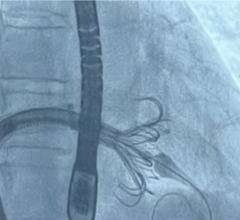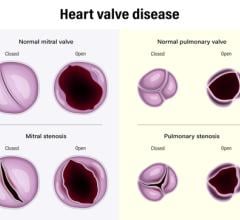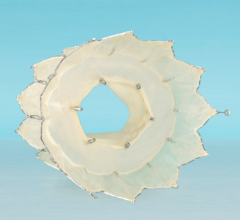
Portico TAVR System image courtesy of St. Jude Medical
September 18, 2015 — St. Jude Medical Inc. announced European CE Mark approval for the 27mm and 29mm Portico transcatheter aortic valve replacement (TAVR) system. The approval follows previous approvals of the 23mm and 25mm Portico valves, allowing St. Jude Medical to offer physicians an expanded range of fully repositionable, retrievable TAVR valve sizes. The Portico valve accommodates a patient’s native anatomy with diameters ranging from 19 to 27 mm.
Aortic stenosis is one of the most common forms of cardiovascular disease in the world, and develops as the aortic heart valve becomes calcified, narrowing the valve and preventing a complete opening. Over time, aortic stenosis disrupts the blood flow from the heart, which causes the heart to pump harder and results in weakening. TAVR procedures provide physicians an additional treatment option for patients with severe aortic stenosis who are considered high risk for open heart surgery.
“Aortic stenosis is a serious, potentially life-threatening condition for patients who are unable to receive a traditional open-heart valve transplant,” said Helge Mollmann, M.D., the cardiology head of transcatheter valve therapies at Kerckhoff Heart Center Bad Nauheim, Germany. “Transcatheter aortic valve replacement has revolutionized how we treat these patients, and by offering a complete portfolio of Portico valve sizing options, St. Jude Medical has further helped broaden the patient population that can be treated with this family of valves.”
The Portico system was developed to simplify TAVR procedures for physicians by improving control, ease of use and accuracy over other commercially available TAVR valves. The system offers the ability for the Portico valve to be fully recaptured and repositioned prior to full deployment and release from the delivery system, providing physicians more options to place the valve in the targeted location. The Portico system has also demonstrated low rates of permanent pacemaker utilizations post-valve implant as a result of heart block and was designed to minimize the risk of paravalvular leak (a leakage of blood caused by a space between the heart tissue and a replacement valve).
During a transfemoral implant procedure, the Portico valve is delivered by catheter through the femoral artery in the leg and is positioned while the patient’s heart continues to beat. Use of the Portico valve alleviates the use of cardiopulmonary bypass, which involves a machine taking over a patient’s heart and lung function during surgery and can cause added strain on an already frail heart.
The 23mm the 25mm Portico transcatheter aortic heart valve are both CE Mark approved and commercially available in Europe. In the United States, the Portico valve is currently being evaluated in a clinical trial through an investigational device exemption (IDE) by the U.S. Food and Drug Administration (FDA). The Portico IDE trial originally launched in May 2014, and is designed to support U.S. approval of the Portico system.
For more information: www.sjm.com


 September 04, 2024
September 04, 2024 








